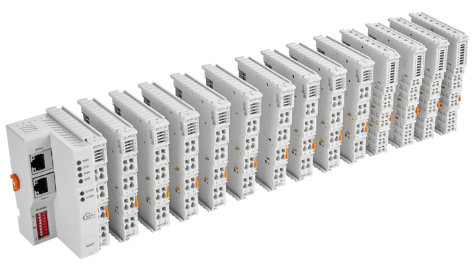#io module
Explore tagged Tumblr posts
Text

The RV Electronique 17631 Interface Module is a high-performance device designed to streamline communication between various industrial automation systems. This interface module plays a crucial role in connecting different control devices, ensuring seamless data transmission and system integration. Ideal for enhancing operational efficiency, the RV Electronique 17631 supports easy setup and reliable performance in complex industrial environments. With its robust design, it provides secure and fast communication, making it a valuable addition to any automated system. Whether for monitoring or controlling machinery, this module simplifies the automation process, boosting productivity and reducing downtime in industrial applications.
#industrial automation#industrial equipment#auto2mation#marine spare parts#industrial spare parts#marine automation#industrial and marine automation#industrial and marine automation equipment#industrial automation equipment#automation#io module#interface module#industrial parts supplier#industrial#automation solutions
0 notes
Text
#bd traders mart#industrial automation#industrial engineering#industrial equipment#plc#hmi#vfd#delta#io module
0 notes
Text
mentioned inside out in my announcement to my students.... #winning
#nebposting#we are learning about memory this week...snuck a lil joy core memory gif and some references into the module introduction 🤭#i love being in psych i can just reference io whenever LMAO. anyways it's soooo late goodnight i just wanted to say this 👍🏾
7 notes
·
View notes
Text

#module#modulewidgets#ios app development#apple#ios#moduleiOS#widgets#app developers#poster design#poster art#graphic art#web graphics#advertising#ads
1 note
·
View note
Text
i just think it’s funny that raspberry pi seems to plan their releases around that of apple’s
#stream#both cult followings ….#that im apart of ………#idk i’ve always been an apple fanthem i guess#perhaps it’s also due to me growing up poor & seeing it as a status symbol but by the time the 5s or so was released they had started being#subsidized for the poors following the monopoly breakup w at&t so i had an what was it it was either an 8 or 16gb 4s for 99c in#it was 2014/2015 or so i don’t remember i still have that fucking phone the back cracked bc my sexy fatass geometry teacher fucking stepped#on my binder on accident during a test u know when in school u had to put ur bag or binder at the front of class during tests#but i also got an ipod touch in like 2012 i think loved it it was green my mother got it for my brother & i for christmas#& that’s when i hopped on the Dual Phone Train#never grew out of it#i had an 14 & se 1st gen now i’m triple wielding bc i got robbed so ptsd ive got 12 mini 15 ? 16 ? idk i dont use it it just stays home that#the tx phone bc it doesn’t have a sim card slot as american so it’s esim only therefore literally an ipod#& that’s what i use it as - i also have my us whatsapp on there & i use it to call my banks#but that’s like once a month#so#triple wielding w the se#i hate the new ios like ios 18 it’s gotten too complicated#literally loved apple bc of its simplicity idk as if i didn’t get a pi to get into software & webhosting as was my dream as a child#literally in elementary school i wanted to build my own website so bad i literally went to the library & was reading books on how to build a#server then i asked my parents & they were like ‘wow that’s so cool :) we don’t have any money :) that’s why u were at the library :) & know#so much about libraries :) bc they’re free :) bc ur poor :)’ ALSKALSKALKSLAKSLALSASL#MORE PPL NEED TO USE LIBRARIES#blessed to live like down the street from a library#actually blessed to literally be living in a ‘15 minute city’#also accidentally ordered a compute module 4 so :/#i thought i was ordering the module 5 ALSJALKSLAKSLAKSLAKSLAKSLKSLA#RASPBERRY DROP THE 5S I KNOW U GOT STOCK FUCK U#i’m literally going to make a dual cloud hosting server & also a website host so i can finally provide my family back home w a website for#them to see when i take pics & stuff
1 note
·
View note
Text
youtube
Best Hugo Themes For Blogs and Portfolio Sites
In this video I'll cover the best Hugo themes for blogs and portfolio sites. Whether you're looking for a clean blog theme or a modern portfolio theme, there's something for everyone.
I'll show you 8 top-notch Hugo themes that offer unique features like video support, responsive design, and more!
Plus, I'll walk you through how to install and customize them for your brand.
#best hugo themes#hugo portfolio themes#hugo blog themes#hugo themes#hugo blog template#hugo templates#hugo website templates#hugo website themes#hugo blog#hugo static site#hugo website#hugo site#hugo static website#hugo site generator#hugo ssg#hugo static site generator#hugo modules#hugo seo#hugo tutorial#hugo bootstrap#hugo cms#hugo framework#hugo#gohugo themes#gohugo io#gohugo#themes#ssg#jamstack#static site generators
1 note
·
View note
Photo

ndustrial IO modules in enhancing process control within Industrial IoT (IIoT) environments. It delves into the functionalities and applications of various IO modules, highlighting their impact on data acquisition, control precision, system visibility, and scalability.
1 note
·
View note
Text
#remote io modules#remote io#remote io module#remote io system#remote io systems#instrutel#local io module#local io modules
0 notes
Text
Allen Bradley 1734 POINT I/O Modules
Modular design lets you independently select the I/O, termination style, and network interface
Modules slide together for easy install and uninstall for easier maintenance
Removable wiring system saves time and money during installation and troubleshooting
Comprehensive diagnostics and configurable features makes POINT I/O easy to apply
Removal and Insertion Under Power (RIUP) lets you replace modules while the system is in operation
Mount horizontally or vertically, with no de-rating required
Auto Device Replacement (ADR) reduces downtime
Add-on-Profiles in the Studio 5000 Logix Designer application provide smooth integration into Integrated Architecture systems
Available with conformal coating
#automation#tumblr trends#bestdeals#allen bradley#trendingnow#rockwell automation#viral#trending#viralpost#plc#technology#tech#technews#computer#point guard io safety modules#point digital dc output modules#service providers#1734-ib8s#1734-ob8s#1734-ie4s
1 note
·
View note
Text
The Features of EtherCAT Distributed I/O Module
Product Introduction
BL202 coupler is a data acquisition and control system based on a powerful 32-bit microprocessor design with a Linux operating system. Support connecting to EtherCAT master station. The field side, the system side and the bus side are electrically isolated from each other. Support 2 X RJ45 interface, integrated switch function, can establish line topology, without the need for additional switches or hubs. Convenient wiring connection technology, screw-free installation.

EtherCAT Features
EtherCAT Distributed I/O modules play a significant role in industrial automation and control systems. EtherCAT Distributed I/O modules provide real-time communication, scalability, reduced wiring complexity, distributed intelligence, high precision and synchronization, open standardization, and flexibility in device placement. These features make them an important component in industrial automation systems, enabling efficient and reliable control of complex processes.
EtherCAT is known for its exceptional real-time performance.
EtherCAT Distributed I/O modules support a scalable architecture, allowing for easy expansion and adaptation to changing automation requirements.
EtherCAT utilizes a daisy-chain topology, where devices are connected in series using a single Ethernet cable.
EtherCAT Distributed I/O modules often feature built-in intelligence and processing capabilities.
EtherCAT's distributed clock mechanism ensures precise synchronization of devices within nanosecond accuracy.
0 notes
Text
Rugged Ethernet I/O Module M420T Pulse Output Control Stepper Motor Driver
Rugged Ethernet I/O Module M420T Digital output supports Sink output, of which the first channel can be used as high-speed pulse output, supporting pulse frequency 10Hz~300KHz.
0 notes
Text

The Abb Ci854 Interface Module is a high-performance communication module designed for seamless integration into Abb automation systems. It supports PROFIBUS DP protocol, enabling efficient communication between field devices and control systems. The module ensures reliable data exchange, making it ideal for industrial applications requiring precision and scalability. With its compact design, the Ci854 is easy to install and fits perfectly in automation setups. Its robust build ensures durability, even in demanding environments. Whether for process control or equipment monitoring, the Abb Ci854 enhances system efficiency and reliability
#industrial automation#industrial equipment#industrial and marine automation#industrial and marine automation equipment#marine automation#marine spare parts#industrial spare parts#auto2mation#industrial automation equipment#automation#abb#industrial#io module
0 notes
Text
Application of Distributed I/O in Lithium Battery Industry

Distributed I/O (Input/Output) is a technology that involves the use of multiple input/output devices and controllers to collect and distribute information throughout a system. In the lithium battery industry, distributed I/O systems are used to monitor and control various aspects of the battery manufacturing process.
One application of distributed I/O in the lithium battery industry is in the monitoring and control of battery production lines. Multiple sensors and controllers are placed at various points along the production line to collect data on parameters such as temperature, pressure, and chemical composition. This data is then transmitted to a central control system where it is analyzed and used to optimize the production process.
Another application of distributed I/O in the lithium battery industry is in the monitoring and control of battery management systems (BMS). BMSs are responsible for monitoring and controlling the state-of-charge, voltage, temperature, and other parameters of individual battery cells. Distributed I/O systems can be used to collect this data from multiple BMSs and transmit it to a central control system for analysis and optimization.
Overall, distributed I/O systems have become an important tool in the lithium battery industry for improving production efficiency, reducing costs, and ensuring product quality and reliability.
0 notes
Text
Zoom MS50G+ Guitar Multi-Effects: A 2023 Upgrade
This new version builds upon the success of its predecessor, the Zoom MS-50G, which has been a go-to choice for guitarists seeking a compact and affordable multi-effect solution for over a decade. While it might not have always been hailed for its ultra-realistic sound and meticulous emulations, the MS-50G packed a lot of versatility into a single stompbox. Enhanced Effects Selection The Zoom…

View On WordPress
#2023#Apple#Compressors#Delays#Drives#filters#Guitar Lab iOS app#iOS#iPad#iPhone#Modulations#MS-50G#MS50G+#pedal#Reverbs#stompbox#Tap Tempo#tuner#video#YouTube#Zoom#Zoom MS50G+
0 notes
Text
ROCKWELL Allen Bradley Input/Output (I/O) Modules
Gain Operational Efficiency with a Wide Range of I/O Solutions Whether your application requires the I/O to operate in harsh environments or hazardous areas, mount on a machine, or act as a local I/O for your programmable controller or more, pick what you need from us. Deliver a smart, productive, and secure Integrated Architecture® system in discrete, process, motion, and safety applications…

View On WordPress
#AB IO module#AB module#โมดูล AB IO#โมดูล Rockwell IO#Модуль ввода-вывода AB#Модуль ввода-вывода Rockwell#input/output module#Mô-đun AB IO#Mô-đun IO Rockwell#Modul AB IO#Modul Rockwell IO#Rockwell IO Module#Rockwell Module#وحدة AB IO#وحدة روكويل IO
0 notes
Text

This translates from the Italian as "The cook cooks the snake" which is getting a little wild for the Italian module, I feel. Although maybe it's like "Io ho l'ape" which is "I have the bee" but as the Italian readers informed me, "ape" is both a bee and a kind of amusing car, so perhaps il serpente is a kind of pastry or something.
Italians, tell me it's a kind of pastry. It's okay to lie if you have to.
[ID: A screengrab of the Duolingo app featuring Falstaff the Bear, who is smiling because I correctly transcribed "Il cuoco cucina un serpente" from an audio recording of him saying it. The phrase in English would read "the cook cooks the snake."]
241 notes
·
View notes